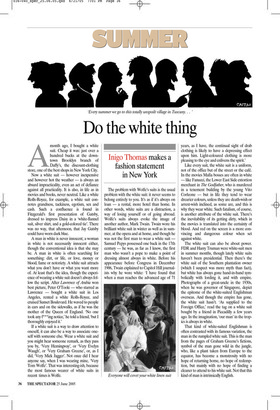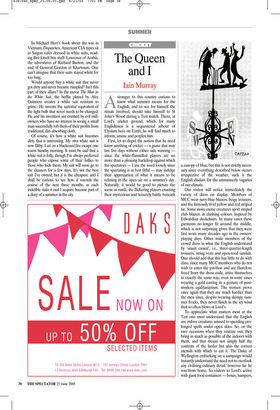Do the white thing
Inigo Thomas makes a fashion statement in New York
Amonth ago, I bought a white suit. Cheap it was: just over a hundred bucks at the downtown Brooklyn branch of Daffy’s, the discount-clothing store, one of the best shops in New York City.
Now a white suit — however inexpensive and however hot the weather — is always an absurd impracticality, even an act of defiance against all practicality. It is also, in life as in movies and books, never neutral. Like a white Rolls-Royce, for example, a white suit connotes grandness, tackiness, egotism, sex and cash. Such a confluence is found in Fitzgerald’s first presentation of Gatsby, dressed to impress Daisy in a ‘white-flannel suit, silver shirt, and a gold-colored tie’. There was no way, that afternoon, that Jay Gatsby could have worn dark blue.
A man in white is never innocent; a woman in white is not necessarily innocent either, though the conventional idea is that she may be. A man in white is often searching for something: dirt, or life, or love, money or blood, fame or notoriety. A white suit attracts what you don’t have or what you want more of. At least that’s the idea, though the experience of wearing a white suit doesn’t always follow the script. After Lawrence of Arabia won best picture, Peter O’Toole — who starred as Lawrence — bought a white suit in Los Angeles, rented a white Rolls-Royce, and cruised Sunset Boulevard. He waved to people in cars and on the sidewalks, as if he was the mother of the Queen of England. ‘No one took any f***ing notice,’ he told a friend, ‘but I thoroughly enjoyed it.’ If a white suit is a way to draw attention to oneself, it can also be a way to associate oneself with someone else. Wear a white suit and you might hear someone remark, as they pass you by, ‘Very Hemingway’, or ‘Very Evelyn Waugh’, or ‘Very Graham Greene’, or, as I did, ‘Very Mick Jagger’. Not once did I hear anyone say, when I was wearing mine, ‘Very Tom Wolfe’. That was interesting-ish, because the most famous wearer of white suits in recent times is Wolfe. The problem with Wolfe’s suits is the usual problem with the white suit: it never seems to belong entirely to you. It’s as if it’s always on loan — a rental, more hotel than home. In other words, white suits are a distraction, a way of losing yourself or of going abroad. Wolfe’s suits always evoke the image of another author, Mark Twain. Twain wore his brilliant white suit in winter as well as in summer, at the opera and at home, and though he was not the first man to wear a white suit Samuel Pepys possessed one back in the 17th century — he was, as far as I know, the first man who wasn’t a pope to make a point of dressing almost always in white. Before his appearance before Congress in December 1906, Twain explained to Capitol Hill journalists why he wore white: ‘I have found that when a man reaches the advanced age of 71 years, as I have, the continual sight of drab clothing is likely to have a depressing effect upon him. Light-coloured clothing is more pleasing to the eye and enlivens the spirit.’ Like every suit, the white suit is a uniform, not of the office but of the street or the café. In the movies Mafia bosses are often in white — like Fanucci, the Lower East Side extortion merchant in The Godfather, who is murdered in a tenement building by the young Vito Corleone — but in life they tend to wear drearier colours, unless they are death-wish or arrest-wish inclined, as some are, and this is why they wear white. Such fatalism, of course, is another attribute of the white suit. There’s the inevitability of its getting dirty, which in the movies is translated into the certainty of blood. And red on the screen is a more convincing and dangerous colour when set against white.
The white suit can also be about power. FDR and Harry Truman were white-suit men in summer months, though lately white suits haven’t been presidential. Then there’s the white suit of the Southern plantation owner (which I suspect was more myth than fact), but white has always gone hand-in-hand symbolically with lording it, and with empire. Photographs of a great-uncle in the 1930s, when he was governor of Singapore, depict the epitome of the white-suited Englishman overseas. And though the empire has gone, the white suit hasn’t. ‘As supplied to the Foreign Office,’ read the tag on a white suit bought by a friend in Piccadilly a few years ago. In the imagination, ‘our man’ in the tropics is always in white.
That kind of white-suited Englishman is often contrasted with its famous variation, the man in the rumpled white suit. This is the man from the pages of Graham Greene’s fictions, symbol of the man gone wild in the jungle, who, like a plant taken from Europe to the equator, has become a monstrosity with no hope of returning home, no hope of redemption, but mainly with no hope of finding a cleaner to attend to his white suit. Not that this kind of man is intrinsically English. In Michael Herr’s book about the war in Vietnam, Dispatches, American CIA types sit in Saigon cafés dressed in white suits, reading Brit kitsch boy stuff: Lawrence of Arabia, the adventures of Richard Burton, and the end of General Gordon at Khartoum. One can’t imagine that their suits stayed white for too long.
Would anyone buy a white suit that never got dirty and never became rumpled? Isn’t this part of their allure? In the movie The Man in the White Suit, the boffin played by Alec Guinness creates a white suit resistant to grime. He invents the sartorial equivalent of the light bulb that never needs to be changed. He and his invention are crushed by evil millowners who have no interest in seeing a small man successfully rob them of their profits from traditional, dirt-absorbing cloth.
Of course, it’s how a white suit becomes dirty that is interesting. My own white suit is now filthy: I sat on a blackened fire escape one warm Sunday morning. It must be said that a white suit is folly, though I’ve always preferred people who expose some of their follies to those who hide them. My suit will soon go to the cleaners for a few days. It’s not the best suit I’ve owned, but it is the cheapest, and I shall be curious to see how it records the course of the next three months, as each indelible stain it and I acquire become part of a diary of a summer in the city.



































































 Previous page
Previous page